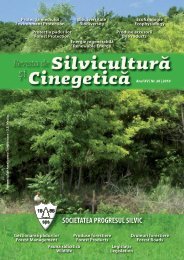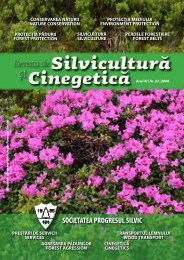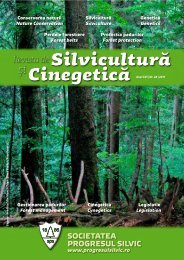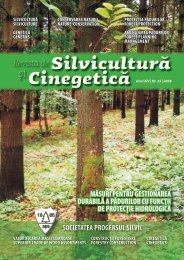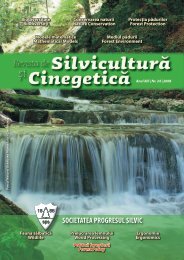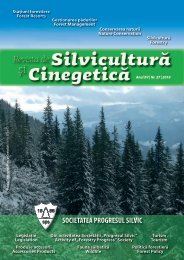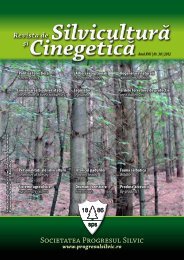Silviculture and Cinegetics Review - Societatea Progresul Silvic
Silviculture and Cinegetics Review - Societatea Progresul Silvic
Silviculture and Cinegetics Review - Societatea Progresul Silvic
You also want an ePaper? Increase the reach of your titles
YUMPU automatically turns print PDFs into web optimized ePapers that Google loves.
FORESTRY POLICY SILVICULTURE AND CINEGETICS REVIEW XVII/30/2012<br />
- Average annual precipitation: 615.5 mm/year;<br />
- Potential evapotranspiration: 732.5 mm/year;<br />
- Potential humidity deficit 127.0 mm/year;<br />
- Strong tendency to reduce average annual<br />
precipitation in the last years;<br />
- During summer appear warm air masses from the<br />
south-west that accelerate evapotranspiration <strong>and</strong><br />
produce a strong humidity deficit.<br />
In the forest steppe <strong>and</strong> steppe floor (isl<strong>and</strong>,<br />
intrazonal) predominate Turkey oak, Hungarian oak,<br />
common oak <strong>and</strong> mixed hardwood forests based<br />
mostly on Grayish oak, <strong>and</strong> in the intrazonal steppe<br />
the majority is represented by Turkey <strong>and</strong> Hungarian<br />
oak <strong>and</strong> less by common oak <strong>and</strong> Grayish oak.<br />
In the terrain subject to this project, the fundamental<br />
natural st<strong>and</strong>s represent about 70 % <strong>and</strong> the artificial<br />
ones 30 % in the northern part of the area <strong>and</strong> a report<br />
almost opposite in the south.<br />
In the studied terrain the vegetation has poor growing<br />
conditions, hence the necessity of settling them in<br />
stationary that are favorable to their ecological needs.<br />
The following is a description of soil types identified<br />
in the field with the physic-chemical (variation limits)<br />
resulted from the laboratory tests.<br />
In the forest steppe <strong>and</strong> steppe area (isl<strong>and</strong>-intrazonal)<br />
the following types of soil have been identified:<br />
Cambic Phaeozem (cambic chernozem) with a Am-<br />
Bv-C profile, formed on loess, on flat or slightly<br />
depressing terrain, with pH = 7.06-7.28, with humus<br />
content on the 20 cm thickness of 2.00-2.54 %,<br />
medium supplied with total nitrogen (0.16-0.23 g %),<br />
mesobasic on surface (V = 80-84 %), medium<br />
edaphic, suitable for culture of Grayish oak, Turkey<br />
oak, Hungarian oak, lime, locust, Tartarian maple etc.<br />
Typical Phaeozem (typical chernozem) with a Am-<br />
Ac-C profile, formed on s<strong>and</strong>s, on flat or slightly<br />
depressing terrain, it is basic with pH = 6.0-7.2 with<br />
humus content of 1.92-2.52 in the first 20 cm, medium<br />
to low supplied with total nitrogen (0.11-0.31 %)<br />
throughout the profile, the degree of base saturation V<br />
= 66-87 %, loamy to s<strong>and</strong>y-clay, medium-deep<br />
edaphic, suitable for culture of Turkey oak, Hungarian<br />
oak, locust, Turkestan elm, etc.<br />
Eutric Regosol (typical, s<strong>and</strong>y) with a Ao-C profile,<br />
formed on s<strong>and</strong>s <strong>and</strong> loess, on flat terrain or old, low,<br />
stable dunes, it is slightly acid with pH = 6.72-7.00,<br />
low humus, medium supplied with total nitrogen at<br />
the surface (0.48), eubasic at surface <strong>and</strong> mesobasic in<br />
depth, with s<strong>and</strong>y-loamy texture on the surface <strong>and</strong><br />
s<strong>and</strong>y-cohesive in depth, medium edaphic, suitable for<br />
culture of locust <strong>and</strong> honey locust (due to low water<br />
retention capacity <strong>and</strong> high evapotranspiration).<br />
In the forest plain area the following types of soils<br />
were identified:<br />
Psammyc Preluvosol (reddish brown clay-alluvial on<br />
s<strong>and</strong>y deposits) with a Ao-Bt-C profile, formed on<br />
s<strong>and</strong>y deposits, on flat or slightly depressing terrain, it<br />
is slightly acid with pH = 6.18-6.49, low content of<br />
humus on the 0-20 cm thickness of 1.26 %, low<br />
supplied with total nitrogen (0.19 %), mesobasic in<br />
Ao (63 %) <strong>and</strong> eubasic in Bt (75 %), s<strong>and</strong>y – loamy,<br />
medium edaphic, suitable for culture of Grayish oak,<br />
Turkey oak, Hungarian oak, locust, honey locust, field<br />
maple, lime, Tartarian maple, etc.<br />
Red Luvisol (reddish brown luvic typical), with a Ao-<br />
El-Bt-C profile, formed on loam <strong>and</strong> loess, on slightly<br />
depressing terrain, with pH = 6.0-7.6 , <strong>and</strong> humus<br />
content = 0.95-3.03 % on the 0-20 cm thickness,<br />
medium supplied with total nitrogen (0.18-0.39 g %)<br />
on the surface, mesobasic to eubasic, loamy to loamy<br />
– clay, medium edaphic, suitable for culture of<br />
Grayish oak, Turkey oak, Hungarian oak, ash, lime,<br />
elm, field maple, locust, honey locust, Tartarian<br />
maple, etc.<br />
Gleyic Cambic Chernozem (Humic glay soil) with a<br />
Am-Bv-Go-Gr profile, formed on loam <strong>and</strong> loess, on<br />
flat terrain, sometimes ab<strong>and</strong>oned meadows, with<br />
ground water near the surface, it is neutral to<br />
moderately alkaline with pH = 8.04, moderate content<br />
of humus on the 20 cm thickness of 2.46 %, very well<br />
supplied with total nitrogen on the surface (0.30 %)<br />
eubasic, loamy to loamy-clay, medium edaphic,<br />
suitable for culture of Grayish oak, Turkey oak,<br />
Hungarian oak, ash, lime, field maple, locust, honey<br />
locust, Tartarian maple, etc.<br />
The following are the site units <strong>and</strong> the main <strong>and</strong><br />
alternative afforestation compositions for the primary<br />
<strong>and</strong> secondary forest belts (Table 1).<br />
Stationary<br />
Units<br />
Table. 1 Site units<br />
Form of<br />
relief<br />
Soil types <strong>and</strong><br />
sub-types<br />
Stationary factors<br />
– limiting <strong>and</strong><br />
compensatory<br />
Composition of<br />
Surface<br />
afforestation - basic <strong>and</strong><br />
alternative ha %<br />
1 2 3 4 5 6 7<br />
24



